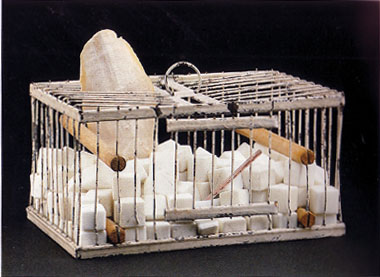
Why Not Sneeze, Rrose Selavy?
 |
| Replica? 1963 |
|
Original Version:
1921, New York |
Clearly more of a construction than a pure Readymade, Why Not Sneeze, Rrose Selavy? consists of multiple parts including 152 white marble cubes meticulously crafted to resemble sugar cubes unless the piece is lifted. On a certain level, Why Not Sneeze, Rrose Selavy?'s categorization as a Readymade is a mystery, as is the answer to its strange question. However, with each cube stamped with a very factory-like, "Made in France," the piece remains very Readymade in certain aspects. As Duchamp explained in a 1956 interview,
| "It was naturally, in trying to draw a conclusion or consequence from the dehumanization of the work of art, that I came to the idea of the Ready-mades. That is the name, as you know, that I gave to those works which in effect are already completely made. Let me show you: this is a Ready-made bird cage with, if you see me, I am having a hard time because this is not sugar, that is marble, and it weighs a ton, and that was one of the elements that interested me when I made it, you see. It is a Ready-made in which the sugar is changed to marble. It is sort of a mythological effect" (Sanouillet & Peterson 135). |
Bailly describes Why Not Sneeze, Rrose Selavy? as a "strange and delicate construction with the built-in surprise that it is far heavier than it looks, a sort of trompe-l'oeil effect that can be verified by touch" (56). However, the museum space ironically forbids such close interaction.
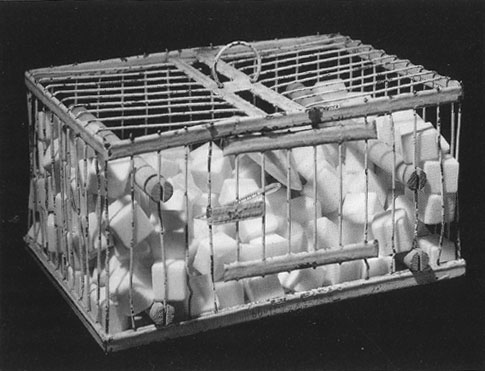 |
| Original version, 1921 |
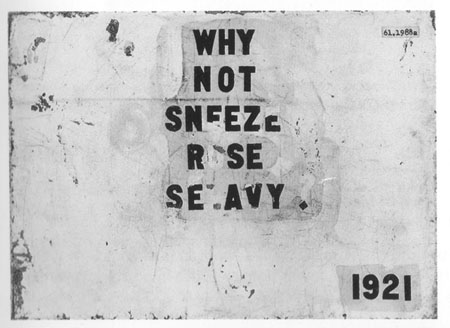 |
| Original version (underside) 1921 |
The title, written in the form of a question, acts as a type of proposition, challenging the viewer to try and answer its inane question. An involuntary reaction, how could one not sneeze, or ever question it? Rrose Selavy's name points in the direction of love and sex: "Eros, C'est la vie." Ramirez notes that the question could ask, in loose translation, "Why is love not easy?" (61). Ades calls the title "comic, as a sneeze is, of course, involuntary..." (164). Also, the weight of the piece produces "another involuntary shudder with the unexpected weight" (Ades 164).
Katherine Dreier's sister Dorothea commissioned Why Not Sneeze, Rrose Selavy? for 300 dollars. However, once Duchamp completed the Readymade, Dorothea was not very pleased. She gave it to Katherine, who kept it in her collection of Duchamp's work until 1937, when she sold it without profit to Walter Arensberg. In effect, both women essentially rejected the Readymade. Ramirez entertains that the reason for this dissatisfaction lies in the piece's sexual meaning (60). The promised lightness and sweetness, but ultimate "excessive weight" and missing warmth do not seem to be "very flattering 'comments' about a woman" (Ramirez 61).
Overall, Mink attests that this piece was not a "success" (7). She explains, "Not many people saw it, and those who did found it hard to understand, but too strange to be meaningless... Duchamp himself didn't help out with explanations: 'This little birdcage is filled with sugar lumps... but the sugar lumps are made of marble and when you lift it, you are surprised by the unexpected weight./ The thermometer is to register the temperature of the marble'" (7).
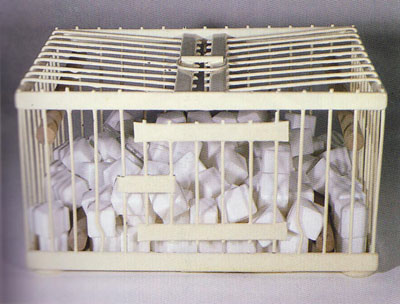 |
| Replica, 1964? |
Andre Breton gives his own recount of this Readymade in his 1924 Wandering Footsteps:
| "I have in mind the occasion when Marcel Duchamp got hold of some friends to show them a cage which seemed to have no birds in it, but to be half-full of lumps of sugar. He asked them to lift the cage and they were surprised at its heaviness. What they had taken for lumps of sugar were really small lumps of marble which at great expense Duchamp had had sawn up specially for the purpose. The trick in my opinion is no worse than any other, and I would even say that it is worth nearly all the tricks of art put together" (Chipp 420). |
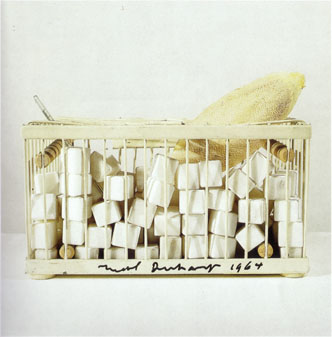 |
| Replica, 1964 |
Replicas:
1) 1963, Stockholm
Moderna Museet, Stockholm
Gift of the Moderna Museets Vanner
Replica by Ulf Linde
2) 1964, Milan
Edition of eight replicas, identical in most ways, but cubes not stamped.
Three outside edition secured for artist, publisher and MoMA, New York.